
- •QoS Overview
- •“Do I Know This Already?” Quiz
- •QoS: Tuning Bandwidth, Delay, Jitter, and Loss Questions
- •Foundation Topics
- •QoS: Tuning Bandwidth, Delay, Jitter, and Loss
- •Bandwidth
- •The clock rate Command Versus the bandwidth Command
- •QoS Tools That Affect Bandwidth
- •Delay
- •Serialization Delay
- •Propagation Delay
- •Queuing Delay
- •Forwarding Delay
- •Shaping Delay
- •Network Delay
- •Delay Summary
- •QoS Tools That Affect Delay
- •Jitter
- •QoS Tools That Affect Jitter
- •Loss
- •QoS Tools That Affect Loss
- •Summary: QoS Characteristics: Bandwidth, Delay, Jitter, and Loss
- •Voice Basics
- •Voice Bandwidth Considerations
- •Voice Delay Considerations
- •Voice Jitter Considerations
- •Voice Loss Considerations
- •Video Basics
- •Video Bandwidth Considerations
- •Video Delay Considerations
- •Video Jitter Considerations
- •Video Loss Considerations
- •Comparing Voice and Video: Summary
- •IP Data Basics
- •Data Bandwidth Considerations
- •Data Delay Considerations
- •Data Jitter Considerations
- •Data Loss Considerations
- •Comparing Voice, Video, and Data: Summary
- •Foundation Summary
- •QoS Tools and Architectures
- •“Do I Know This Already?” Quiz
- •QoS Tools Questions
- •Differentiated Services Questions
- •Integrated Services Questions
- •Foundation Topics
- •Introduction to IOS QoS Tools
- •Queuing
- •Queuing Tools
- •Shaping and Policing
- •Shaping and Policing Tools
- •Congestion Avoidance
- •Congestion-Avoidance Tools
- •Call Admission Control and RSVP
- •CAC Tools
- •Management Tools
- •Summary
- •The Good-Old Common Sense QoS Model
- •GOCS Flow-Based QoS
- •GOCS Class-Based QoS
- •The Differentiated Services QoS Model
- •DiffServ Per-Hop Behaviors
- •The Class Selector PHB and DSCP Values
- •The Assured Forwarding PHB and DSCP Values
- •The Expedited Forwarding PHB and DSCP Values
- •The Integrated Services QoS Model
- •Foundation Summary
- •“Do I Know This Already?” Quiz Questions
- •CAR, PBR, and CB Marking Questions
- •Foundation Topics
- •Marking
- •IP Header QoS Fields: Precedence and DSCP
- •LAN Class of Service (CoS)
- •Other Marking Fields
- •Summary of Marking Fields
- •Class-Based Marking (CB Marking)
- •Network-Based Application Recognition (NBAR)
- •CB Marking show Commands
- •CB Marking Summary
- •Committed Access Rate (CAR)
- •CAR Marking Summary
- •Policy-Based Routing (PBR)
- •PBR Marking Summary
- •VoIP Dial Peer
- •VoIP Dial-Peer Summary
- •Foundation Summary
- •Congestion Management
- •“Do I Know This Already?” Quiz
- •Queuing Concepts Questions
- •WFQ and IP RTP Priority Questions
- •CBWFQ and LLQ Questions
- •Comparing Queuing Options Questions
- •Foundation Topics
- •Queuing Concepts
- •Output Queues, TX Rings, and TX Queues
- •Queuing on Interfaces Versus Subinterfaces and Virtual Circuits (VCs)
- •Summary of Queuing Concepts
- •Queuing Tools
- •FIFO Queuing
- •Priority Queuing
- •Custom Queuing
- •Weighted Fair Queuing (WFQ)
- •WFQ Scheduler: The Net Effect
- •WFQ Scheduling: The Process
- •WFQ Drop Policy, Number of Queues, and Queue Lengths
- •WFQ Summary
- •Class-Based WFQ (CBWFQ)
- •CBWFQ Summary
- •Low Latency Queuing (LLQ)
- •LLQ with More Than One Priority Queue
- •IP RTP Priority
- •Summary of Queuing Tool Features
- •Foundation Summary
- •Conceptual Questions
- •Priority Queuing and Custom Queuing
- •CBWFQ, LLQ, IP RTP Priority
- •Comparing Queuing Tool Options
- •“Do I Know This Already?” Quiz
- •Shaping and Policing Concepts Questions
- •Policing with CAR and CB Policer Questions
- •Shaping with FRTS, GTS, DTS, and CB Shaping
- •Foundation Topics
- •When and Where to Use Shaping and Policing
- •How Shaping Works
- •Where to Shape: Interfaces, Subinterfaces, and VCs
- •How Policing Works
- •CAR Internals
- •CB Policing Internals
- •Policing, but Not Discarding
- •Foundation Summary
- •Shaping and Policing Concepts
- •“Do I Know This Already?” Quiz
- •Congestion-Avoidance Concepts and RED Questions
- •WRED Questions
- •FRED Questions
- •Foundation Topics
- •TCP and UDP Reactions to Packet Loss
- •Tail Drop, Global Synchronization, and TCP Starvation
- •Random Early Detection (RED)
- •Weighted RED (WRED)
- •How WRED Weights Packets
- •WRED and Queuing
- •WRED Summary
- •Flow-Based WRED (FRED)
- •Foundation Summary
- •Congestion-Avoidance Concepts and Random Early Detection (RED)
- •Weighted RED (WRED)
- •Flow-Based WRED (FRED)
- •“Do I Know This Already?” Quiz
- •Compression Questions
- •Link Fragmentation and Interleave Questions
- •Foundation Topics
- •Payload and Header Compression
- •Payload Compression
- •Header Compression
- •Link Fragmentation and Interleaving
- •Multilink PPP LFI
- •Maximum Serialization Delay and Optimum Fragment Sizes
- •Frame Relay LFI Using FRF.12
- •Choosing Fragment Sizes for Frame Relay
- •Fragmentation with More Than One VC on a Single Access Link
- •FRF.11-C and FRF.12 Comparison
- •Foundation Summary
- •Compression Tools
- •LFI Tools
- •“Do I Know This Already?” Quiz
- •Foundation Topics
- •Call Admission Control Overview
- •Call Rerouting Alternatives
- •Bandwidth Engineering
- •CAC Mechanisms
- •CAC Mechanism Evaluation Criteria
- •Local Voice CAC
- •Physical DS0 Limitation
- •Max-Connections
- •Voice over Frame Relay—Voice Bandwidth
- •Trunk Conditioning
- •Local Voice Busyout
- •Measurement-Based Voice CAC
- •Service Assurance Agents
- •SAA Probes Versus Pings
- •SAA Service
- •Calculated Planning Impairment Factor
- •Advanced Voice Busyout
- •PSTN Fallback
- •SAA Probes Used for PSTN Fallback
- •IP Destination Caching
- •SAA Probe Format
- •PSTN Fallback Scalability
- •PSTN Fallback Summary
- •Resource-Based CAC
- •Resource Availability Indication
- •Gateway Calculation of Resources
- •RAI in Service Provider Networks
- •RAI in Enterprise Networks
- •RAI Operation
- •RAI Platform Support
- •Cisco CallManager Resource-Based CAC
- •Location-Based CAC Operation
- •Locations and Regions
- •Calculation of Resources
- •Automatic Alternate Routing
- •Location-Based CAC Summary
- •Gatekeeper Zone Bandwidth
- •Gatekeeper Zone Bandwidth Operation
- •Single-Zone Topology
- •Multizone Topology
- •Zone-per-Gateway Design
- •Gatekeeper in CallManager Networks
- •Zone Bandwidth Calculation
- •Gatekeeper Zone Bandwidth Summary
- •Integrated Services / Resource Reservation Protocol
- •RSVP Levels of Service
- •RSVP Operation
- •RSVP/H.323 Synchronization
- •Bandwidth per Codec
- •Subnet Bandwidth Management
- •Monitoring and Troubleshooting RSVP
- •RSVP CAC Summary
- •Foundation Summary
- •Call Admission Control Concepts
- •Local-Based CAC
- •Measurement-Based CAC
- •Resources-Based CAC
- •“Do I Know This Already?” Quiz
- •QoS Management Tools Questions
- •QoS Design Questions
- •Foundation Topics
- •QoS Management Tools
- •QoS Device Manager
- •QoS Policy Manager
- •Service Assurance Agent
- •Internetwork Performance Monitor
- •Service Management Solution
- •QoS Management Tool Summary
- •QoS Design for the Cisco QoS Exams
- •Four-Step QoS Design Process
- •Step 1: Determine Customer Priorities/QoS Policy
- •Step 2: Characterize the Network
- •Step 3: Implement the Policy
- •Step 4: Monitor the Network
- •QoS Design Guidelines for Voice and Video
- •Voice and Video: Bandwidth, Delay, Jitter, and Loss Requirements
- •Voice and Video QoS Design Recommendations
- •Foundation Summary
- •QoS Management
- •QoS Design
- •“Do I Know This Already?” Quiz
- •Foundation Topics
- •The Need for QoS on the LAN
- •Layer 2 Queues
- •Drop Thresholds
- •Trust Boundries
- •Cisco Catalyst Switch QoS Features
- •Catalyst 6500 QoS Features
- •Supervisor and Switching Engine
- •Policy Feature Card
- •Ethernet Interfaces
- •QoS Flow on the Catalyst 6500
- •Ingress Queue Scheduling
- •Layer 2 Switching Engine QoS Frame Flow
- •Layer 3 Switching Engine QoS Packet Flow
- •Egress Queue Scheduling
- •Catalyst 6500 QoS Summary
- •Cisco Catalyst 4500/4000 QoS Features
- •Supervisor Engine I and II
- •Supervisor Engine III and IV
- •Cisco Catalyst 3550 QoS Features
- •Cisco Catalyst 3524 QoS Features
- •CoS-to-Egress Queue Mapping for the Catalyst OS Switch
- •Layer-2-to-Layer 3 Mapping
- •Connecting a Catalyst OS Switch to WAN Segments
- •Displaying QoS Settings for the Catalyst OS Switch
- •Enabling QoS for the Catalyst IOS Switch
- •Enabling Priority Queuing for the Catalyst IOS Switch
- •CoS-to-Egress Queue Mapping for the Catalyst IOS Switch
- •Layer 2-to-Layer 3 Mapping
- •Connecting a Catalyst IOS Switch to Distribution Switches or WAN Segments
- •Displaying QoS Settings for the Catalyst IOS Switch
- •Foundation Summary
- •LAN QoS Concepts
- •Catalyst 6500 Series of Switches
- •Catalyst 4500/4000 Series of Switches
- •Catalyst 3550/3524 Series of Switches
- •QoS: Tuning Bandwidth, Delay, Jitter, and Loss
- •QoS Tools
- •Differentiated Services
- •Integrated Services
- •CAR, PBR, and CB Marking
- •Queuing Concepts
- •WFQ and IP RTP Priority
- •CBWFQ and LLQ
- •Comparing Queuing Options
- •Conceptual Questions
- •Priority Queuing and Custom Queuing
- •CBWFQ, LLQ, IP RTP Priority
- •Comparing Queuing Tool Options
- •Shaping and Policing Concepts
- •Policing with CAR and CB Policer
- •Shaping with FRTS, GTS, DTS, and CB Shaping
- •Shaping and Policing Concepts
- •Congestion-Avoidance Concepts and RED
- •WRED
- •FRED
- •Congestion-Avoidance Concepts and Random Early Detection (RED)
- •Weighted RED (WRED)
- •Flow-Based WRED (FRED)
- •Compression
- •Link Fragmentation and Interleave
- •Compression Tools
- •LFI Tools
- •Call Admission Control Concepts
- •Local-Based CAC
- •Measurement-Based CAC
- •Resources-Based CAC
- •QoS Management Tools
- •QoS Design
- •QoS Management
- •QoS Design
- •LAN QoS Concepts
- •Catalyst 6500 Series of Switches
- •Catalyst 4500/4000 Series of Switches
- •Catalyst 3550/3524 Series of Switches
- •Foundation Topics
- •QPPB Route Marking: Step 1
- •QPPB Per-Packet Marking: Step 2
- •QPPB: The Hidden Details
- •QPPB Summary
- •Flow-Based dWFQ
- •ToS-Based dWFQ
- •Distributed QoS Group–Based WFQ
- •Summary: dWFQ Options
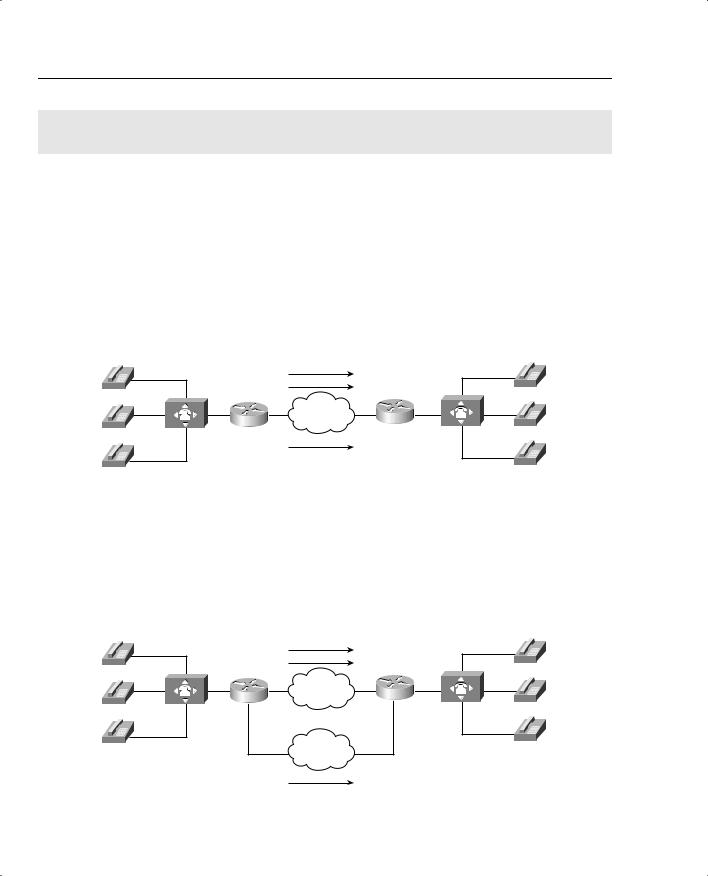
626 Chapter 8: Call Admission Control and QoS Signaling
Foundation Summary
The “Foundation Summary” is a collection of tables and figures that provide a convenient review of many key concepts in this chapter. For those of you already comfortable with the topics in this chapter, this summary could help you recall a few details. For those of you who just read this chapter, this review should help solidify some key facts. For any of you doing your final prep before the exam, these tables and figures are a convenient way to review the day before the exam.
Figure 8-35 shows the effect of a VoIP network without the use of CAC.
Figure 8-35 VoIP Network Without CAC
IP Network Supports 2 Calls Max!
|
Call 1 |
|
|
Call 2 |
|
R1 |
IP Network |
R2 |
|
Call 3
The Third Call Degrades Voice Quality for All Calls
Figure 8-36 shows how CAC can be used in a legacy VoIP network to redirect a call to the PSTN in the even that sufficient resources are not available to carry the call on the data network.
Figure 8-36 Legacy VoIP Network with CAC
IP Network Supports 2 Calls Max!
|
Call 1 |
|
|
Call 2 |
|
R1 |
IP Network |
R2 |
|
PSTN
Call 3
CAC Reroutes the Third Call Through the PSTN

Foundation Summary 627
Figure 8-37 shows how CAC can be used in an IP telephony network to redirect a call to the PSTN in the event that sufficient resources are not available to carry the call on the data network.
Figure 8-37 IP Telephony Network with CAC
|
IP Network Supports 2 Calls Max! |
|
|
|
Host Site |
Call 1 |
Remote Site |
||
|
|
Call 2 |
|
|
IP |
R1 |
IP Network |
R2 |
IP |
|
||||
Host Phone A |
|
|
|
Remote |
|
|
|
|
Phone A |
IP |
SW1 |
PSTN |
SW2 |
IP |
Host Phone B |
|
|
||
|
|
|
|
Remote |
|
|
Call 3 |
|
Phone B |
|
|
|
|
|
IP |
|
CAC Reroutes the Third Call |
|
|
Host Phone C |
|
|
IP |
|
|
|
Through the PSTN |
|
|
|
|
|
Remote |
|
|
|
|
|
|
|
|
|
|
Phone C |
CallManager |
CallManager |
|
|
|
Publisher |
Subscriber |
|
|
|
Table 8-26 illustrates a few of the possible G.711 and G.729 bandwidth requirements.
Table 8-26 Bandwidth Requirements
|
Payload |
|
|
|
Packets |
|
|
per |
IP/UDP/RTP |
L2 Header |
L2 Header |
per |
Bandwidth |
Codec |
Packet |
Header Size |
Type |
Size |
Second |
per Call |
|
|
|
|
|
|
|
G.711 |
160 bytes |
40 bytes |
Ethernet |
14 bytes |
50 pps |
85.6 kbps |
|
|
|
|
|
|
|
G.711 |
240 bytes |
40 bytes |
Ethernet |
14 bytes |
33 pps |
77.6 kbps |
|
|
|
|
|
|
|
G.711 |
160 bytes |
40 bytes |
MLPPP/FR |
6 bytes |
50 pps |
82.4 kbps |
|
|
|
|
|
|
|
G.711 |
160 bytes |
2 bytes (cRTP) |
MLPPP/FR |
6 bytes |
50 pps |
67.2 kbps |
|
|
|
|
|
|
|
G.729 |
20 bytes |
40 bytes |
Ethernet |
14 bytes |
50 pps |
29.6 kbps |
|
|
|
|
|
|
|
G.729 |
20 bytes |
40 bytes |
MLPPP/FR |
6 bytes |
50 pps |
26.4 kbps |
|
|
|
|
|
|
|
G.729 |
30 bytes |
40 bytes |
MLPPP/FR |
6 bytes |
33 pps |
20 kbps |
|
|
|
|
|
|
|
G.729 |
20 bytes |
2 bytes (cRTP) |
MLPPP/FR |
6 bytes |
50 pps |
11.2 kbps |
|
|
|
|
|
|
|
*For DQOS test takers: These numbers are extracted from the DQOS course, so you can study those numbers. Note, however, that the numbers in the table and following examples do not include the L2 trailer overhead.

628 Chapter 8: Call Admission Control and QoS Signaling
Figure 8-38 illustrates the packet structure of the layer 2 and IP/UDP/RTP headers and the payload for a voice packet.
Figure 8-38 Voice Packet Structure
Layer 2 |
IP |
UDP |
RTP |
Payload of Speech Samples |
Variable |
|
|
|
Variable Size Based on Codec |
Size |
20 |
8 |
12 |
Selection and Number of |
Based on |
Bytes |
Bytes |
Bytes |
Speech Samples Included |
Layer 2 |
|
|
|
|
Protocol |
|
|
|
|
|
|
|
|
|
Table 8-27 describes the criteria that is used to evaluate the different CAC tools.
Table 8-27 CAC Feature Evaluation Criteria
Evaluation Criteria |
Description |
|
|
Voice over X (VoX) |
The voice technologies to which the CAC method applies, such as VoIP |
supported |
and VoFR. Some methods apply to a single technology, whereas other |
|
methods apply to multiple technologies. |
|
|
Toll bypass or IP telephony |
Whether the method is suitable for use only between voice gateways |
|
connected to the PSTN or a PBX (toll bypass), or will the method |
|
function with IP Phone endpoints (IP telephony). |
|
|
Platforms and releases |
The Cisco IOS platforms this feature is available on, and the software |
|
release in which it was introduced. |
|
|
PBX trunk types supported |
Some CAC features have a dependency on the PSTN or PBX trunk type |
|
used in the connection, or act differently with CCS trunks versus CAS |
|
trunks. |
|
|
End-to-end, local, or IP |
The scope of visibility of the CAC feature. Some mechanisms work |
cloud |
locally on the originating gateway only, others consider the cloud |
|
between the source and destination nodes, some consider the destination |
|
POTS interface, and some work end to end. |
|
|
Per call, interface, or |
Different mechanisms involve different elements of the network. Several |
endpoint |
CAC methods work per call, but some work per interface and some work |
|
per endpoint or IP destination. |
|
|
Topology awareness |
Whether the CAC mechanism takes into account the topology of the |
|
network, and therefore provides protection for the links and nodes in the |
|
topology. |
|
|
Guarantees QoS for |
Whether the mechanism make a one-time decision before allowing the |
duration of call |
call, or whether it also protects the QoS of the call for the duration of the |
|
call by reserving the required resources. |
|
|
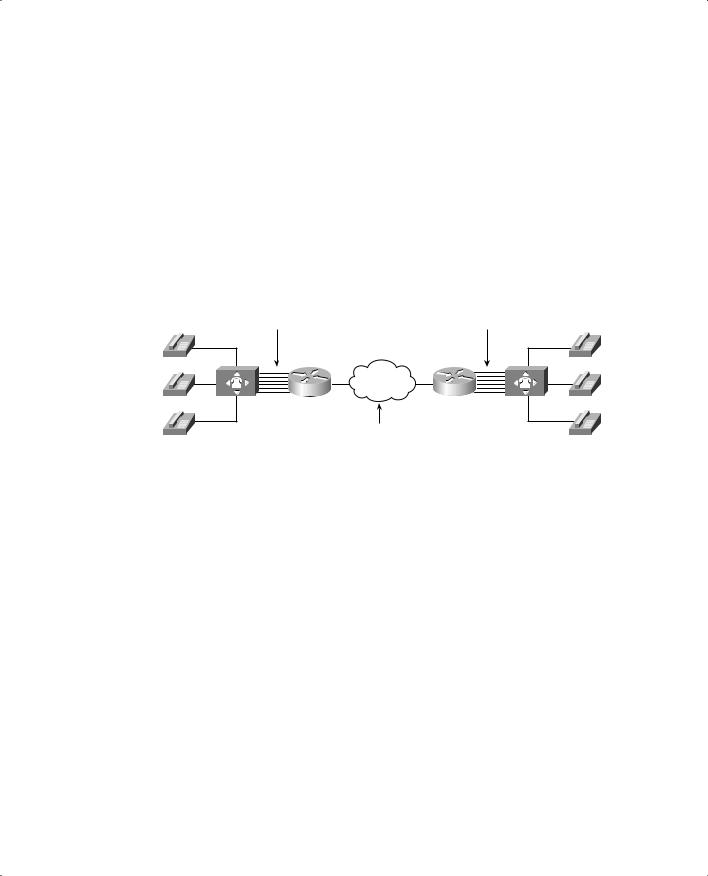
|
|
Foundation Summary 629 |
|
|
|
Table 8-27 CAC Feature Evaluation Criteria (Continued) |
||
|
|
|
|
Evaluation Criteria |
Description |
|
|
|
|
Postdial delay |
Whether the mechanism imposes an additional postdial delay because it |
|
|
requires extra messaging or processing during call setup. |
|
|
|
|
Messaging network |
Whether the method uses additional messaging that must be provisioned |
|
overhead |
in the network to gather the information necessary for the CAC decision. |
|
|
|
Figure 8-39 illustrates a network using physical DS0 limitation to provide CAC.
Figure 8-39 VoIP Physical DS0 Limitation
Six Physical Connections Between Each PBX and Router
R1 |
IP Network |
R2 |
IP Network Designed to Handle up to Six G.729 Calls
Table 8-28 evaluates the physical DS0 limitation mechanism against the CAC evaluation criteria described earlier in this chapter.
Table 8-28 DS0 Limitation CAC Evaluation Criteria
Evaluation Criteria |
Value |
|
|
VoX supported |
Independent of the VoX technology used |
|
|
Toll bypass or IP Telephony |
Toll bypass only |
|
|
Platforms and releases |
All voice gateways and all Cisco IOS releases |
|
|
PBX trunk types supported |
All |
|
|
End to end, local, or IP cloud |
Local |
|
|
Per call, interface, or endpoint |
Per DS0/trunk (per call) |
|
|
Topology awareness |
None |
|
|
Guarantees QoS for duration of call |
None |
|
|
Postdial delay |
None |
|
|
Messaging network overhead |
None |
|
|
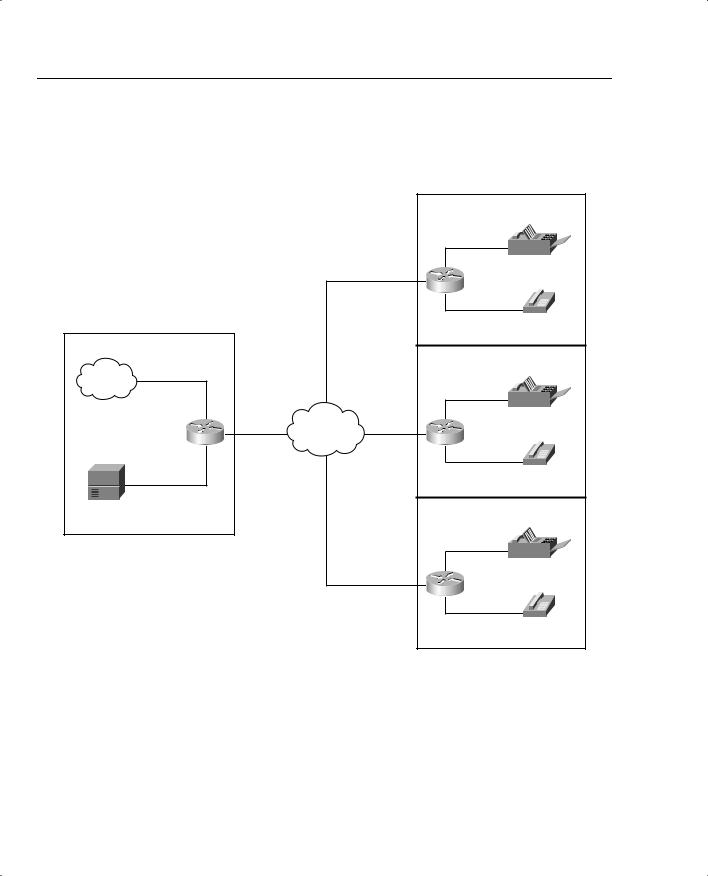
630 Chapter 8: Call Admission Control and QoS Signaling
Figure 8-40 shows a typical VoIP network that can use the max-conn command to limit the number of calls between locations.
Figure 8-40 Max-Connections Multi-Site
|
|
|
|
Remote Site 1 |
|
|
|
512 kbps |
4 Fax Machines |
|
|
|
Circuit |
Extensions 12xx |
|
|
|
|
10 Telephones |
|
Host Site |
|
|
Extensions 12xx |
|
|
|
|
|
|
|
|
|
Remote Site 2 |
PSTN |
T1 PRI |
|
|
|
|
|
|
|
|
|
|
|
512 kbps |
4 Fax Machines |
|
T1 Circuit |
IP WAN |
Circuit |
Extensions 13xx |
|
|
|
|
|
|
|
|
|
10 Telephones |
|
T1 PRI |
|
|
Extensions 13xx |
|
|
|
|
|
PBX |
|
|
|
Remote Site 3 |
Extensions 5xxx |
|
|
|
|
|
|
|
|
4 Fax Machines |
|
|
|
|
Extensions 14xx |
|
|
|
512 kbps |
|
|
|
|
Circuit |
|
|
|
|
|
10 Telephones |
|
|
|
|
Extensions 14xx |
Table 8-29 evaluates the Max-Connections mechanism against the CAC evaluation criteria described earlier in this chapter.
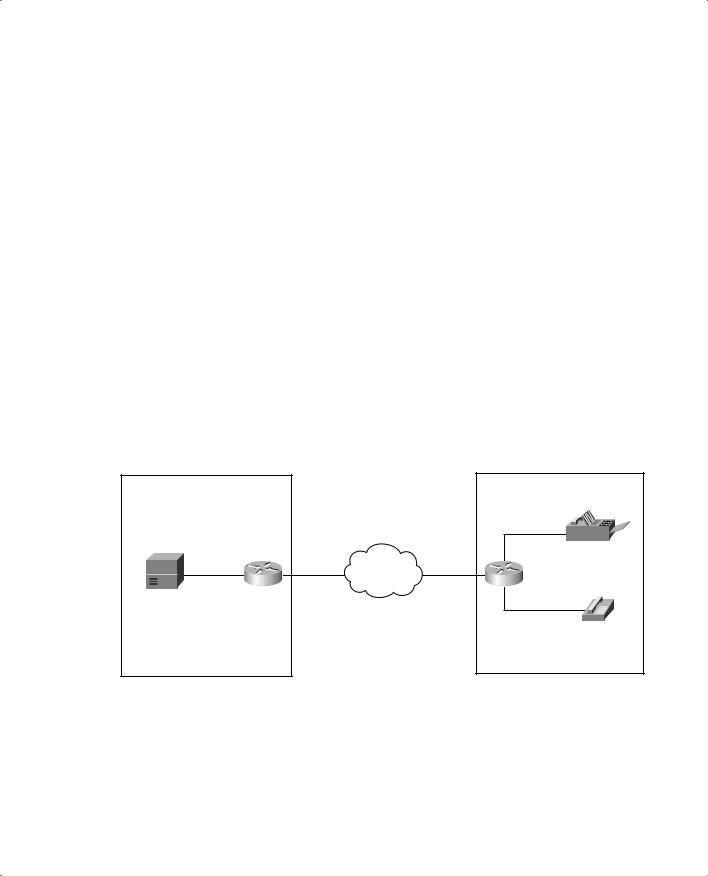
|
|
Foundation Summary 631 |
|
|
|
Table 8-29 Max-Connections CAC Evaluation Criteria |
||
|
|
|
|
Evaluation Criteria |
Value |
|
|
|
|
VoX supported |
All VoX that use dial peers |
|
|
|
|
Toll bypass or IP telephony |
Toll bypass only |
|
|
|
|
Platforms and releases |
All voice gateways and all Cisco IOS releases |
|
|
|
|
PBX trunk types supported |
All |
|
|
|
|
End to end, local, or IP cloud |
Local |
|
|
|
|
Per call, interface, or endpoint |
Per dial peer |
|
|
|
|
Topology awareness |
None |
|
|
|
|
Guarantees QoS for duration of call |
None |
|
|
|
|
Postdial delay |
None |
|
|
|
|
Messaging network overhead |
None |
|
|
|
Figure 8-41 shows a typical VoFR network that can use the frame-relay voice-bandwidth command to limit the number of calls between locations.
Figure 8-41 Voice over Frame Relay (VoFR)
Host Site |
|
|
|
Remote Site |
|
|
256 kbps |
|
256 kbps |
4 Fax Machines |
|
|
Frame |
Extensions 12xx |
|||
T1 PRI |
Circuit |
Circuit |
|||
Relay |
|
||||
|
|
|
|
||
PBX |
|
|
|
|
|
Extensions 5xxx |
|
|
|
|
|
|
|
|
|
10 Telephones |
|
|
|
|
|
Extensions 12xx |
Table 8-30 evaluates the VoFR Voice-Bandwidth mechanism against the CAC evaluation criteria described earlier in this chapter.
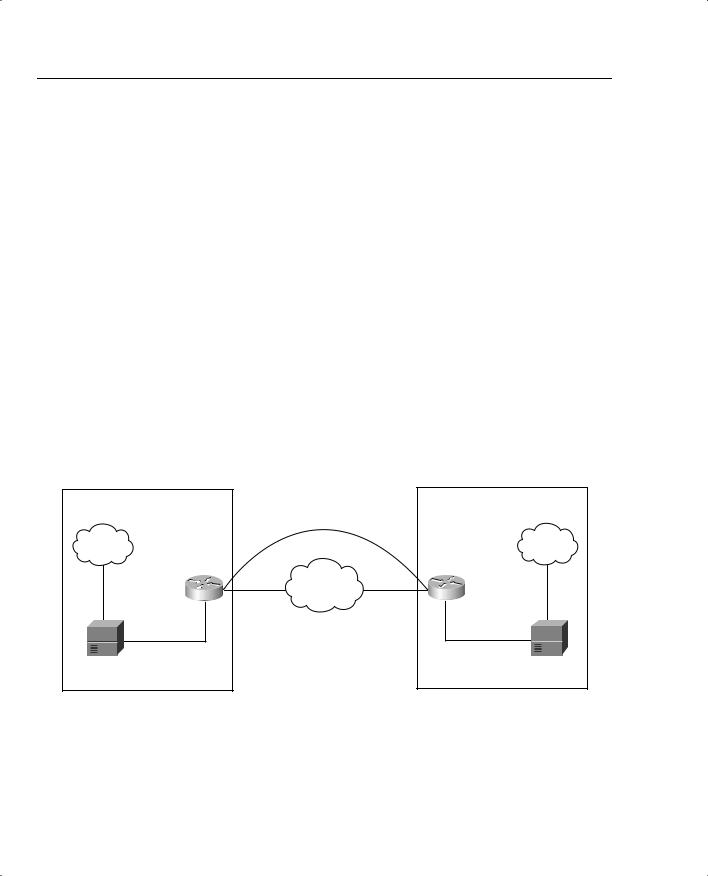
632 Chapter 8: Call Admission Control and QoS Signaling
Table 8-30 VoFR Voice-Bandwidth CAC Evaluation Criteria
Evaluation Criteria |
Value |
|
|
VoX supported |
VoFR |
|
|
Toll bypass or IP telephony |
Toll bypass only |
|
|
Platforms and releases |
Cisco 2600s, 3600s, 3810, and 7200 router; Cisco IOS |
|
Release 12.0(4)T |
|
|
PBX trunk types supported |
All |
|
|
End to end, local, or IP cloud |
Local |
|
|
Per call, interface, or endpoint |
Per call, per PVC |
|
|
Topology awareness |
None |
|
|
Guarantees QoS for duration of call |
None |
|
|
Postdial delay |
None |
|
|
Messaging network overhead |
None |
|
|
Figure 8-42 shows a VoIP network using the connection trunk command to emulate a circuit switched network.
Figure 8-42 Trunk Conditioning
Host Site |
Connection |
Remote Site |
|
|
|
|
Trunk |
|
PSTN |
|
PSTN |
256 kbps |
|
256 kbps |
Circuit |
Frame Relay |
Circuit |
|
|
|
T1 PRI |
|
|
PBX |
|
PBX |
Table 8-31 evaluates the trunk conditioning mechanism against the CAC evaluation criteria described earlier in this chapter.
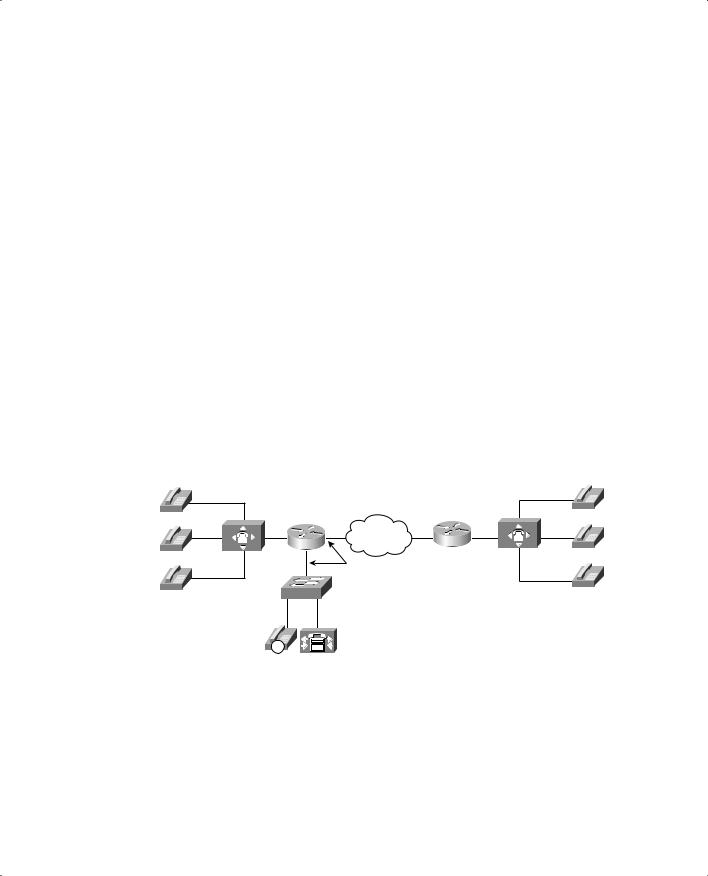
|
|
Foundation Summary 633 |
|
|
|
Table 8-31 Trunk Conditioning CAC Evaluation Criteria |
||
|
|
|
|
Evaluation Criteria |
Value |
|
|
|
|
VoX supported |
VoIP/H.323, VoFR, VoATM (connection trunk configurations |
|
|
only) |
|
|
|
|
Toll bypass or IP telephony |
Toll bypass applications only |
|
|
|
|
Platforms and Releases |
Cisco 2600 and 3600 series routers, and Cisco MC3810 |
|
|
multiaccess concentrators; Cisco IOS Release 12.1(3)T |
|
|
|
|
PBX trunk types supported |
Analog and CAS |
|
|
|
|
End to end, local, or IP cloud |
Local |
|
|
|
|
Per call, interface, or endpoint |
Per telephony interface |
|
|
|
|
Topology awareness |
None |
|
|
|
|
Guarantees QoS for duration of call |
None |
|
|
|
|
Postdial delay |
None |
|
|
|
|
Messaging network overhead |
None; uses preexisting connection trunk keepalives |
|
|
|
Figure 8-43 shows a VoIP network using Local Voice Busyout to provide CAC.
Figure 8-43 Local Voice Busyout
R1 |
IP Network |
R2 |
|
||
|
Interface Failure |
|
SW1
IP
CallManager
Table 8-32 evaluates the Local Voice Busyout mechanism against the CAC evaluation criteria described earlier in this chapter.
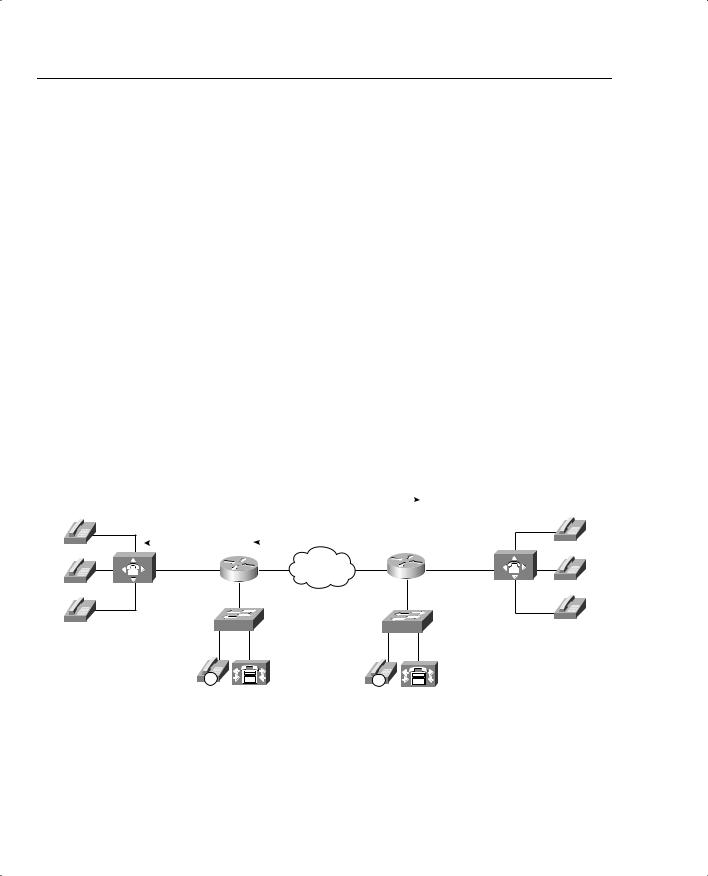
634 Chapter 8: Call Admission Control and QoS Signaling
Table 8-32 Local Voice Busyout CAC Evaluation Criteria
Evaluation Criteria |
Value |
|
|
VoX supported |
All |
|
|
Toll bypass or IP telephony |
Trunking (calls originating from PBX and terminating to IP |
|
telephony destinations) |
|
|
Platforms and releases |
Cisco 2600 and 3600 series routers, MC3810 multiaccess |
|
concentrators; Cisco IOS Release 12.1(2)T |
|
|
PBX trunk types supported |
Analog and CAS |
|
|
End-to-end, local, or IP cloud |
Local |
|
|
Per call, interface, or endpoint |
Per WAN, LAN, and telephony interface |
|
|
Topology awareness |
None |
|
|
Guarantees QoS for duration of call |
None |
|
|
Postdial delay |
None |
|
|
Messaging network overhead |
None |
|
|
Figure 8-44 shows a VoIP network using Advanced Voice Busyout to provide CAC.
Figure 8-44 Advanced Voice Busyout
|
|
SAA Probe sent across the IP network. |
|
|
|
|
SAA Probe responds. Congestions detected |
||
|
|
across the WAN; ICPIF or delay/loss |
||
Busy-Out This Trunk |
|
exceeded threshold. |
||
|
|
|
|
|
R1 |
IP Network |
R2 |
|
||
SW1 |
|
SW2 |
IP |
|
IP |
CallManager |
|
CallManager |
Table 8-33 evaluates the AVBO mechanism against the CAC evaluation criteria described earlier in this chapter.
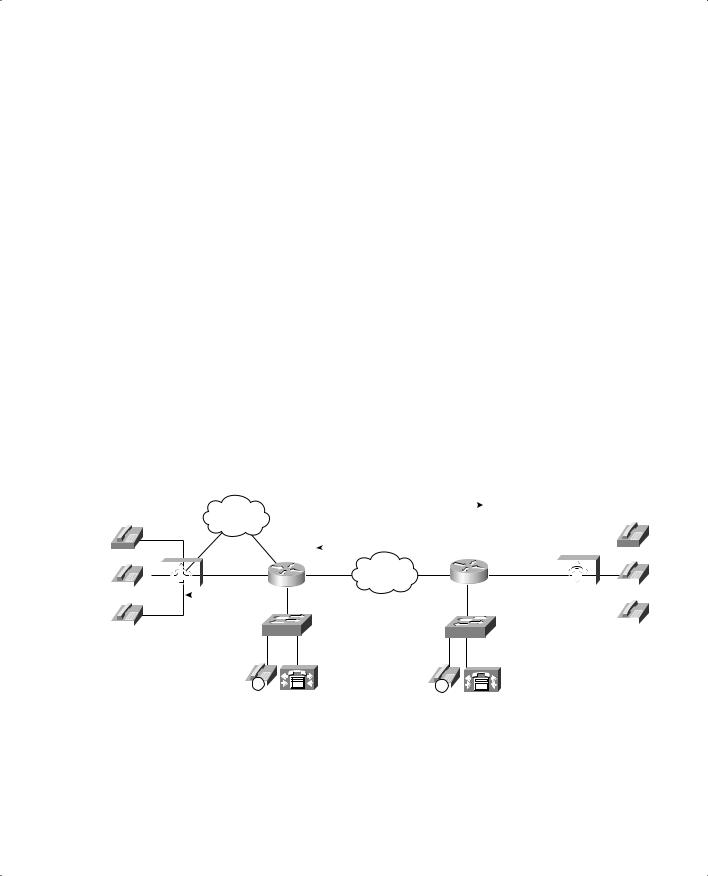
|
|
Foundation Summary 635 |
|
|
|
Table 8-33 Advanced Voice Busyout CAC Evaluation Criteria |
||
|
|
|
|
Evaluation Criteria |
Value |
|
|
|
|
VoX supported |
VoIP only |
|
|
|
|
Toll bypass or IP telephony |
Toll bypass (calls originating from PBX and terminating to IP |
|
|
telephony destinations) |
|
|
|
|
Platforms and releases |
2600s, 3600sand MC3810 with Release 12.1(3)T |
|
|
All router platforms with Release 12.2 Mainline |
|
|
|
|
PBX trunk types supported |
Analog and CAS |
|
|
|
|
End to end, local, or IP cloud |
IP cloud |
|
|
|
|
Per call, interface, or endpoint |
Per IP destination |
|
|
|
|
Topology awareness |
None |
|
|
|
|
Guarantees QoS for duration of call |
None |
|
|
|
|
Postdial delay |
None |
|
|
|
|
Messaging network overhead |
Periodic SAA probes |
|
|
|
Figure 8-45 shows a VoIP network using PSTN fallback to provide CAC.
Figure 8-45 PSTN Fallback
|
|
|
|
|
|
|
|
|
SAA Probe sent across the IP network. |
|
|
|
|
|
|
|
|
|||
|
|
|
|
|
|
|
PSTN |
SAA Probe response. Congestions detected |
|
|
|
|
|
|
|
|||||
|
|
|
|
|
|
|
|
|
across the WAN; ICPIF or delay/loss |
|
|
|
|
|
|
|
||||
|
|
|
|
|
|
|
|
|
exceeded threshold. |
|
|
|
|
|
|
|
|
|
|
|
|
|
|
|
|
|
|
R1 |
|
IP Network |
R2 |
|
|
|
|
|
|
|
|
||
|
|
|
|
|
|
|
|
|
|
|
|
|
|
|
||||||
|
|
|
|
|
|
|
|
|
|
|
|
|
|
|||||||
|
|
|
|
|
|
|
|
|
|
|
|
|
|
|||||||
|
|
|
|
|
|
|
|
|
|
|
|
|
|
|
|
|||||
|
|
|
|
|
|
|
|
|
|
|
|
|
|
|
|
|
|
|
|
|
|
|
|
|
|
|
|
SW1 |
|
|
SW2 |
|
|
|
|
|
|
|
|||
|
|
|
|
|
|
|
|
|
|
|
|
|
|
|
|
|||||
|
|
|
|
|
|
|
|
|
|
|
|
|
|
|
|
|||||
|
|
|
|
|
|
|
|
|
|
|
|
|
|
|
|
|||||
|
|
|
|
|
|
|
|
|
|
|
|
|
|
|
|
|||||
Possible Destinations for Redirection: |
|
|
|
|
|
|
|
|
|
|
|
|
||||||||
•Alternate IP Destinations
•Gateway Connection to PSTN
• Hairpin Call to PBX |
|
|
|
|
|
|
|
|
|
|
|
|
|
|
|
|
|
|
|
|
|
|
|
|
|
|
|
|
|
|
|
|
|
|
|
|
|
|
|
|
|
(CAS and Analog) |
|
|
|
|
|
|
|
|
|
|
|
|
|
IP |
|
|
|
|
IP |
|
|
|
|||||
|
|
|
|||||||||||
• Reject Call to PBX (ISDN) |
|
|
CallManager |
|
|
CallManager |
|||||||
• Reorder Tone |
|
|
|
|
|
|
|
|
|
|
|
|
|

636 Chapter 8: Call Admission Control and QoS Signaling
Table 8-34 lists the options and default values of the call fallback command.
Table 8-34 Call Fallback Command
Call Fallback Command |
|
Default |
Keyword |
Description |
Value |
|
|
|
cache-size x |
Specifies the call fallback cache size for network traffic |
128 |
|
probe entries. |
|
|
|
|
cache-timeout x |
Specifies the time after which the cache entries of |
600s |
|
network conditions are purged. |
|
|
|
|
instantaneous-value-weight x |
Specifies that the call fallback subsystem take an average |
66 |
|
from the last two cache entries for call requests. |
|
|
|
|
jitter-probe num-packets x |
Specifies the number of packets in a jitter probe used to |
15 |
|
determine network conditions. |
|
|
|
|
jitter-probe precedence x |
Specifies the priority of the jitter-probe transmission. |
2 |
|
|
|
jitter-probe priority-queue |
Assigns a priority queue for jitter-probe transmissions. |
Off |
|
|
|
key-chain |
Specifies MD5 authentication for sending and receiving |
None |
|
SAA probes. |
|
|
|
|
map subnet |
Specifies that the call fallback router keep a cache table |
None |
|
by subnet addresses of distances for several destination |
|
|
peers sitting behind the router. |
|
|
|
|
probe-timeout x |
Sets the timeout for an SAA probe for call fallback |
30s |
|
purposes. |
|
|
|
|
threshold delay x loss y |
Specifies that the call fallback threshold use only packet |
None |
|
delay and loss values. |
|
|
|
|
icpif x |
Specifies that the call fallback use the ICPIF threshold. |
10 |
|
|
|
Figure 8-46 illustrates the call setup process for PSTN fallback.
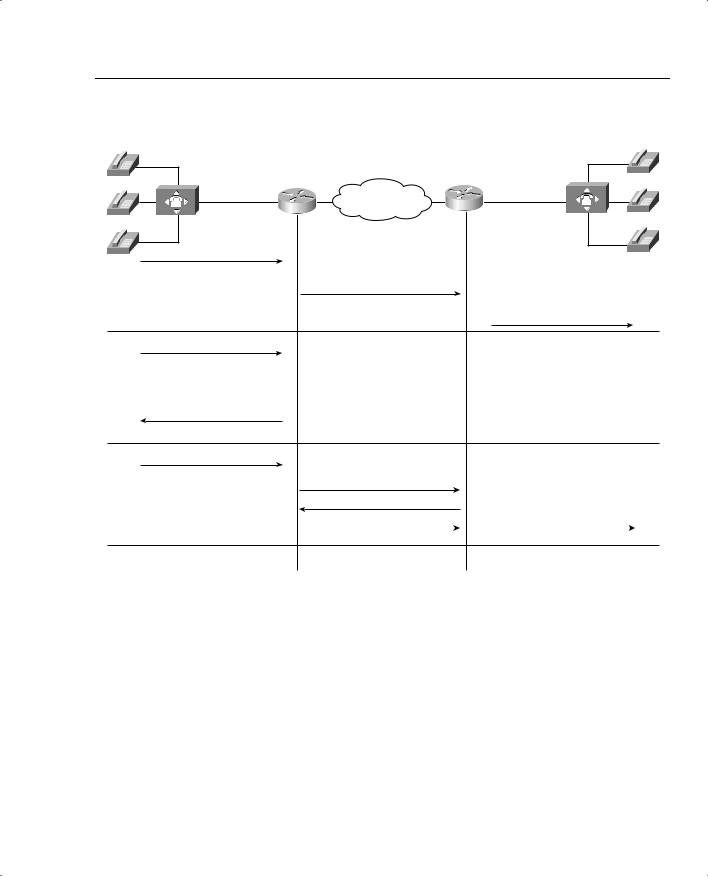
Foundation Summary 637
Figure 8-46 PSTN Fallback Call Setup
Call Setup
1Scenario
Call Setup
2Scenario Call Reject / Hairpin
Call Setup 3Scenario
R1 |
IP Network |
R2 |
|
Cache entry for IP address found; CAC values are acceptable.
Call Setup
Call Setup
Cache entry for IP address found; CAC values not acceptable and no secondary dial-peer exists.
Cache entry for IP address not found.
SAA Probe
SAA Response
Call Setup |
|
Call Setup |
Table 8-35 evaluates the PSTN fallback mechanism against the CAC evaluation criteria described earlier in this chapter.

638 Chapter 8: Call Admission Control and QoS Signaling
Table 8-35 PSTN Fallback CAC Evaluation Criteria
Evaluation Criteria |
Value |
|
|
VoX supported |
VoIP only |
|
|
Toll bypass or IP telephony |
Toll bypass; however, calls originating from a PBX and |
|
terminating to IP telephony destinations can be protected |
|
|
Platforms and releases |
Cisco 2600/3600, MC3810: Release 12.1.(3)T |
|
AS5300: Release 12.2.(2)T |
|
7200/7500 support SAA responder |
|
|
PBX trunk types supported |
All PBX/PSTN trunk signaling types (analog, digital CAS |
|
and CCS) |
|
For analog and digital CAS—alternate IP destination, |
|
hairpin |
|
For digital CCS, reject the call to the PBX or PSTN for |
|
rerouting |
|
|
End to end, local, or IP cloud |
IP cloud |
|
|
Per call, interface, or endpoint |
Per active/cached IP destination |
|
|
Topology awareness |
None |
|
|
Guarantees QoS for duration of call |
None |
|
|
Postdial delay |
Only for first call that initiates probe |
|
|
Messaging network overhead |
Periodic SAA probes |
|
|
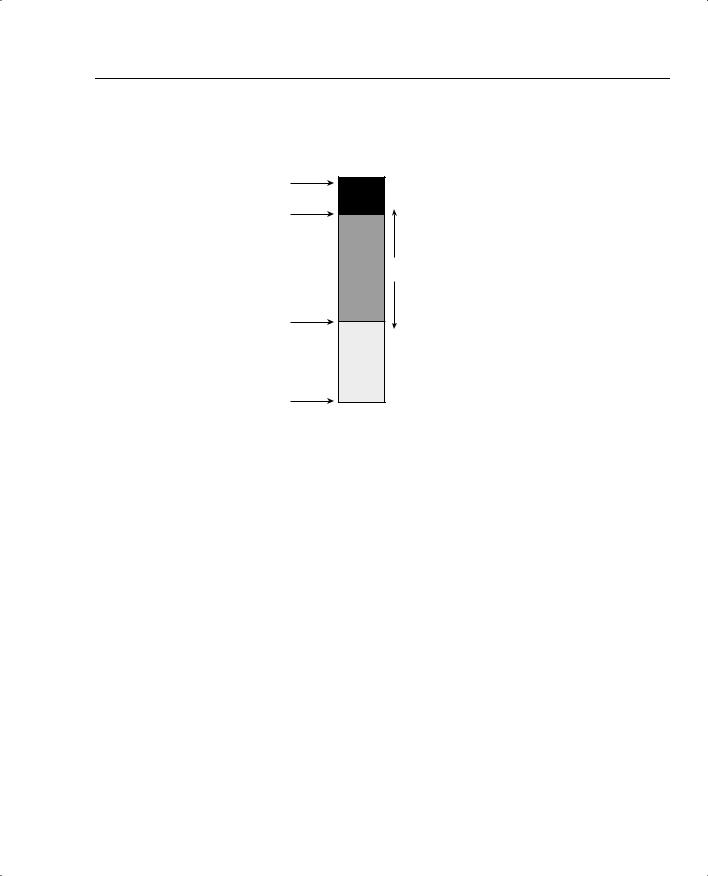
Foundation Summary 639
Figure 8-47 illustrates how a CAC decision is made with resource availability indication (RAI).
Figure 8-47 RAI Configuration
100% |
|
High Water Mark |
Gateway Sends RAI Unavailable |
|
Message to Gatekeeper |
Low Water Mark |
Gateway Sends RAI Available |
Message to Gatekeeper |
|
0% |
|
Table 8-36 evaluates the RAI mechanism against the CAC evaluation criteria described earlier in this chapter.
Table 8-36 RAI CAC Evaluation Criteria
Evaluation Criteria |
Value |
|
|
VoX supported |
VoIP only |
|
|
Toll bypass or IP telephony |
Toll bypass |
|
Potentially IP telephony, but CM does not yet support RAI |
|
|
Platforms and releases |
Cisco AS5300 access server: Cisco IOS Release 12.0(5)T |
|
Cisco 2600 and 3600 series routers T1/E1: Cisco IOS |
|
Release 12.1(3)T |
|
|
PBX trunk types supported |
All |
|
|
End to end, local, or IP cloud |
Local at the terminating gateway (DSP and DS0 resources; |
|
algorithm platform dependent) |
|
|
Per call, interface, or endpoint |
Per gateway |
|
|
Topology awareness |
None |
|
|
Guarantees QoS for duration of call |
None |
|
|
Postdial delay |
None |
|
|
Messaging network overhead |
Occasional RAI toggle between gateway and gatekeeper |
|
|
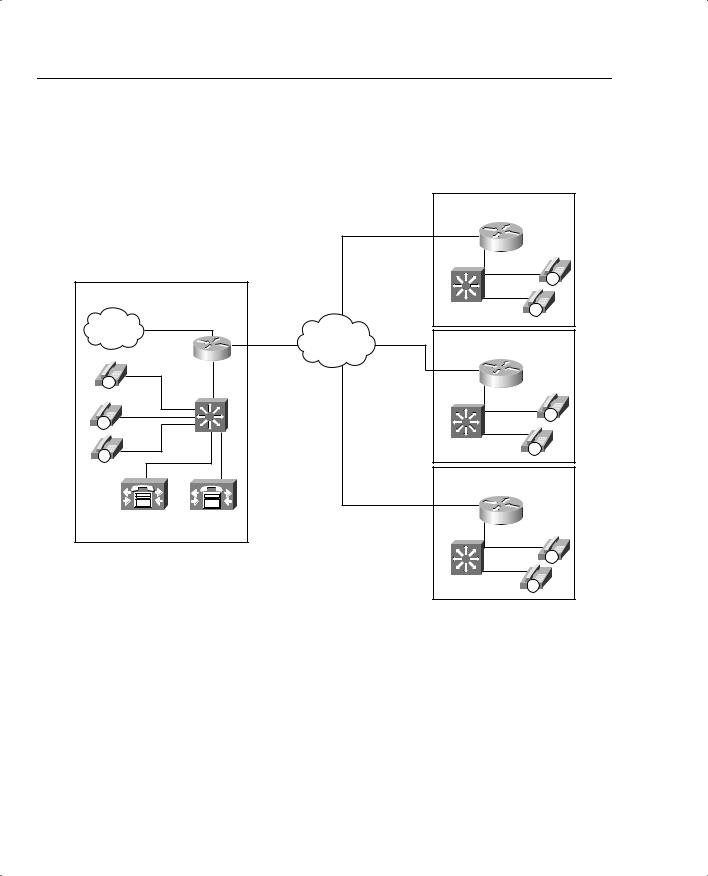
640 Chapter 8: Call Admission Control and QoS Signaling
Figure 8-48 illustrates a typical CallManager centralized call-processing model using locations to provide CAC.
Figure 8-48 CallManager Centralized Call-Processing Model with Regions and Locations Defined
|
|
|
|
|
Location: Atlanta |
|
|
|
|
|
256 kbps |
Region: A |
|
|
|
|
|
|
|
|
|
|
|
|
Circuit |
|
|
|
|
|
|
|
|
IP |
|
Host Site |
|
|
|
|
|
|
|
|
|
|
Catalyst |
IP |
|
T1 PRI |
768 kbps |
|
Switch |
|
|
PSTN |
|
|
|
|||
|
|
|
Location: San Jose |
|||
|
|
|
Circuit |
IP WAN |
||
|
|
|
|
Region: B |
|
|
|
|
|
|
256 kbps |
|
|
|
|
|
|
Circuit |
|
|
IP |
|
|
|
|
|
|
IP |
|
|
|
|
|
IP |
|
|
|
|
|
|
|
|
|
Catalyst |
|
|
Catalyst |
IP |
|
|
Switch |
|
|
||
IP |
|
|
|
Switch |
||
|
|
|
|
|
||
|
|
|
|
|
Location: Dallas |
|
|
|
|
|
|
Region: C |
|
CallManager |
CallManager |
|
256 kbps |
|
|
|
|
Circuit |
|
|
|||
Publisher |
Subscriber |
|
|
|
||
|
|
|
|
|||
|
|
|
|
|
|
IP |
|
|
|
|
|
Catalyst |
IP |
|
|
|
|
|
Switch |
|
|
|
|
|
|
|
|
Table 8-37 shows the amount of bandwidth that will be subtracted, per call, from the total allotted bandwidth for a configured region.
Table 8-37 Location-Based CAC Resource Calculations
Codec |
Bandwidth Reserved |
|
|
G.711 |
80 kbps |
|
|
G.729 |
24 kbps |
|
|
G.723 |
24 kbps |
|
|
GSM |
29 kbps |
|
|
Wideband |
272 kbps |
|
|

Foundation Summary 641
Table 8-38 evaluates location-based CAC against the CAC evaluation criteria described earlier in this chapter.
Table 8-38 Location-Based CAC Evaluation Criteria
Evaluation Criteria |
Value |
|
|
VoX supported |
VoIP only |
|
|
Toll bypass or IP telephony |
IP Telephony only |
|
|
Platforms and releases |
CallManager 3.0 |
|
(AAR was added in CallManager release 3.3.) |
|
|
PBX trunk types supported |
None |
|
|
End to end, local, or IP cloud |
End-to-end between originating and terminating location, |
|
although locations have no knowledge of the network topology |
|
in between |
|
|
Per call, interface, or endpoint |
Per call |
|
|
Topology awareness |
None |
|
|
Guarantees QoS for duration of call |
None |
|
|
Postdial delay |
None |
|
|
Messaging network overhead |
None |
|
|
Figure 8-49 shows a single-zone gatekeeper-controlled VoIP network with two gateways that illustrates gatekeeper CAC in its simplest form.
Figure 8-49 Simple Single-Zone Topology
Gatekeeper
R1 |
IP Network |
R2 |
|
Call 1 Is Allowed
Call 2 Is Allowed
Call 3 Is Denied
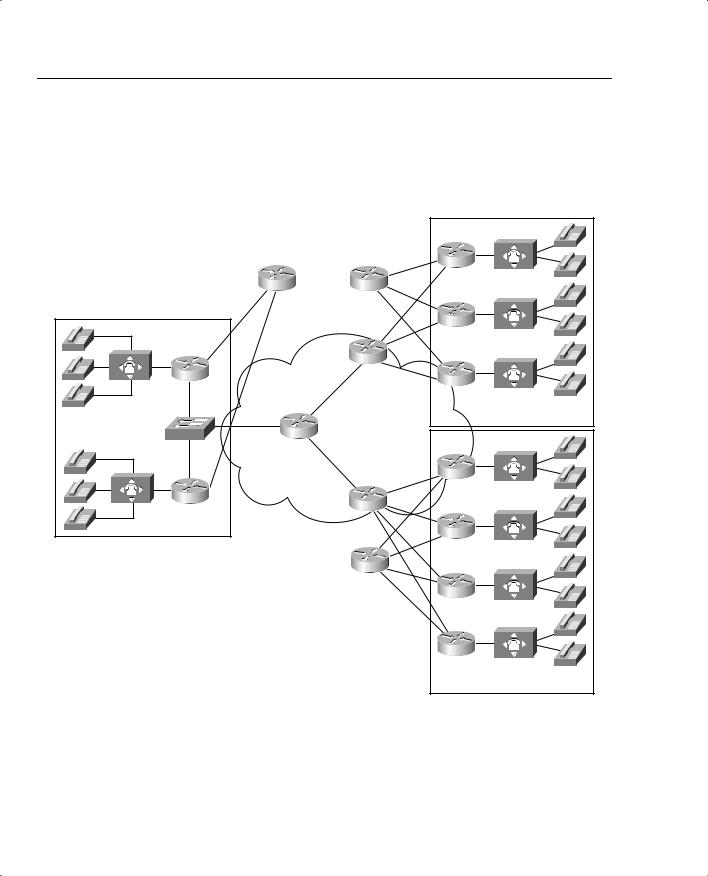
642 Chapter 8: Call Admission Control and QoS Signaling
Figure 8-50 shows a more complex enterprise multizone multigatekeeper-controlled VoIP network.
Figure 8-50 Complex Enterprise Multizone Topology
Zone 1 to Any Zone Limited to 128 kbps
HQ-Gatekeeper
Internal Zone HQ Traffic Is Unlimited
Zone HQ to Zone 1 Limited to 128 kbps
Zone HQ to Zone 2 Limited to 256 kbps
Headquarters |
20 |
|
|
Zone HQ |
|
Site 1-Gatekeeper
2
4
6
4
Remote Site 1
Zone 1
6
2
2
10
Site 2-Gatekeeper |
5 |
|
Remote Site 2
Zone 2
Zone 2 to Zone 1 Limited to 128 kbps
Zone 2 to Zone HQ Limited to 256 kbps
Figure 8-51 shows a pair of CallManager clusters using a gatekeeper to provide CAC between the clusters.
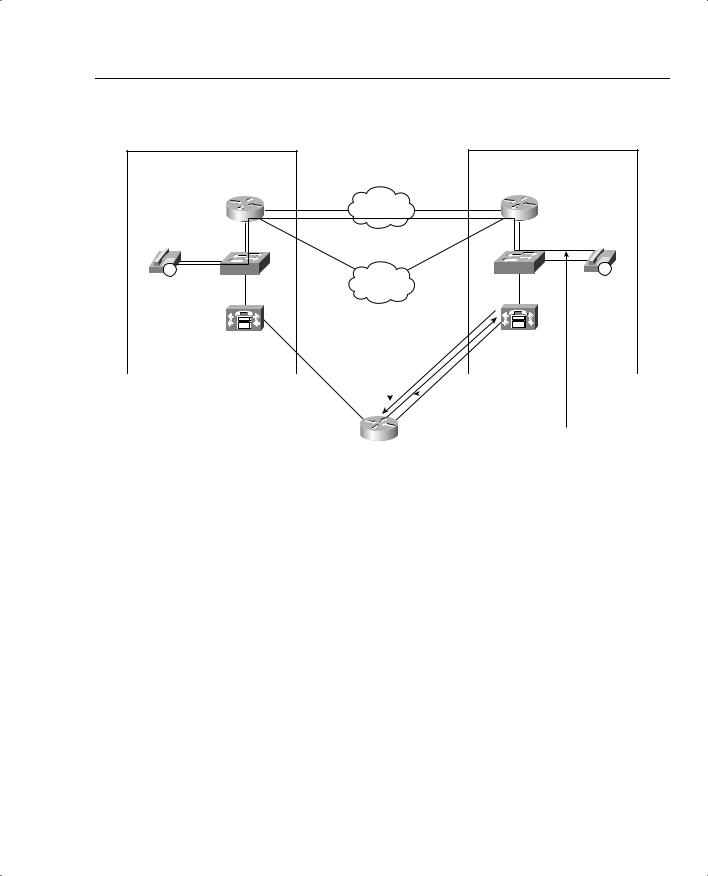
Foundation Summary 643
Figure 8-51 Gatekeeper in a CallManager Topology |
|
|
||
|
CallManager |
|
CallManager |
|
|
Cluster A |
|
|
Cluster B |
|
R1 |
IP Network |
R1 |
|
|
|
|
||
IP |
SW1 |
|
SW1 |
IP |
x1111 |
|
PSTN |
|
x2111 |
|
Can I Make a Call? (ARQ) |
||||
CallManager |
|
|
|
|
CallManager |
|
|
|
|
||
Zone 1 |
|
|
|
|
Zone 2 |
|
|
|
|
|
|
|
|
|
|
Yes You Can (ACF) or |
|
|
|
|
|
No You Cannot (ARJ) |
|
Call Is Placed if Allowed
Gatekeeper
Tables 8-39 and 8-40 list the gatekeeper commands and options used to configure gatekeeper zone bandwidth.
Table 8-39 Gatekeeper Bandwidth Command
Command |
Mode and Function |
|
|
bandwidth {interzone | total | session} |
Specifies the gatekeeper zone bandwidth restrictions |
{default | zone zone-name} max- |
|
bandwidth |
|
|
|
bandwidth remote max-bandwidth |
Specifies the total bandwidth for H.323 traffic between |
|
this gatekeeper and any other gatekeeper |
|
|

644 Chapter 8: Call Admission Control and QoS Signaling
Table 8-40 Gatekeeper Bandwidth Command Options
Bandwidth |
|
Command |
|
Options |
Function |
|
|
interzone |
Specifies the total amount of bandwidth for H.323 traffic from the zone to any |
|
other zone. |
|
|
total |
Specifies the total amount of bandwidth for H.323 traffic allowed in the zone. |
|
|
session |
Specifies the maximum bandwidth allowed for a session in the zone. |
|
|
default |
Specifies the default value for all zones. |
|
|
zone |
|
zone-name |
Names the particular zone. |
|
|
max-bandwidth |
Maximum bandwidth. For interzone and total, the range is from 1 to 10,000,000 |
|
kbps. For session, the range is from 1 to 5000 kbps. |
|
|
Table 8-41 evaluates the gatekeeper zone bandwidth mechanism against the CAC evaluation criteria described earlier in this chapter.
Table 8-41 Gatekeeper Zone Bandwidth CAC Evaluation Criteria
Evaluation Criteria |
Value |
|
|
VoX supported |
VoIP/H.323 only |
|
|
Toll bypass or IP telephony |
Toll bypass and IP telephony |
|
(Some caveats exist if both the CallManager and Cisco IOS gateways |
|
are used in the same zone.) |
|
|
Platforms and releases |
Cisco IOS gateways since Release 11.3 |
|
(CM has recent changes in E.164 registration, and bandwidth |
|
requested per call.) |
|
|
PBX trunk types supported |
All |
|
|
End to end, local, or IP cloud |
End-to-end between originating gateway and terminating gateway, |
|
although not aware of the network topology in between |
|
|
Per call, interface, or endpoint |
Per call |
|
|
Topology awareness |
None |
|
|
Guarantees QoS for duration |
None |
of call |
|
|
|
Postdial delay |
None |
|
|
Messaging network overhead |
Part of the gatekeeper RAS messaging |
|
|
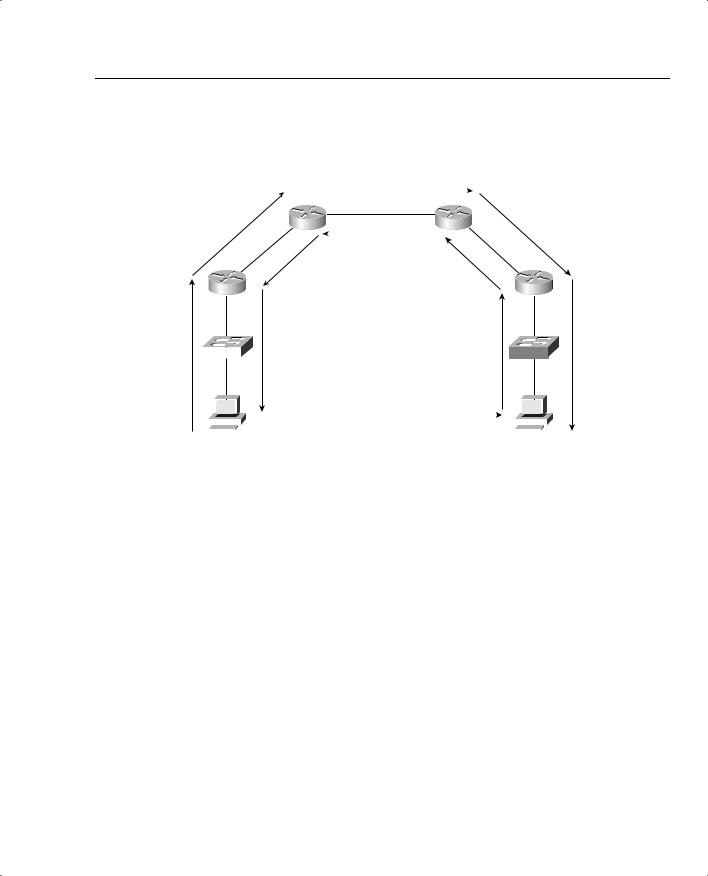
Foundation Summary 645
Figure 8-52 shows the flow of RSVP path and resv messages through the network.
Figure 8-52 RSVP Path and Resv Messages
|
|
|
PATH Messages |
|
|
|
|
R2 |
|
R3 |
|
|
|
|
|
|
|
|
|
|
RESV Messages |
||
R1 |
|
|
R4 |
||
|
|
|
|
|
|
|
|
|
|
|
|
|
|
|
|
|
|
|
|
Data Flow |
|
|
||||||
|
|
|
|
|
|
|
|
|
|
|
|
|
|
|
|
|
|
|
|
|
|
|
|
|
|
|
|
|
|
|
|
|
|
Sending |
|
Receiving |
||||||||||||||
Application |
|
Application |
||||||||||||||
Figure 8-53 shows a call flow of the H.323 call setup messages and the RSVP reservation messages.
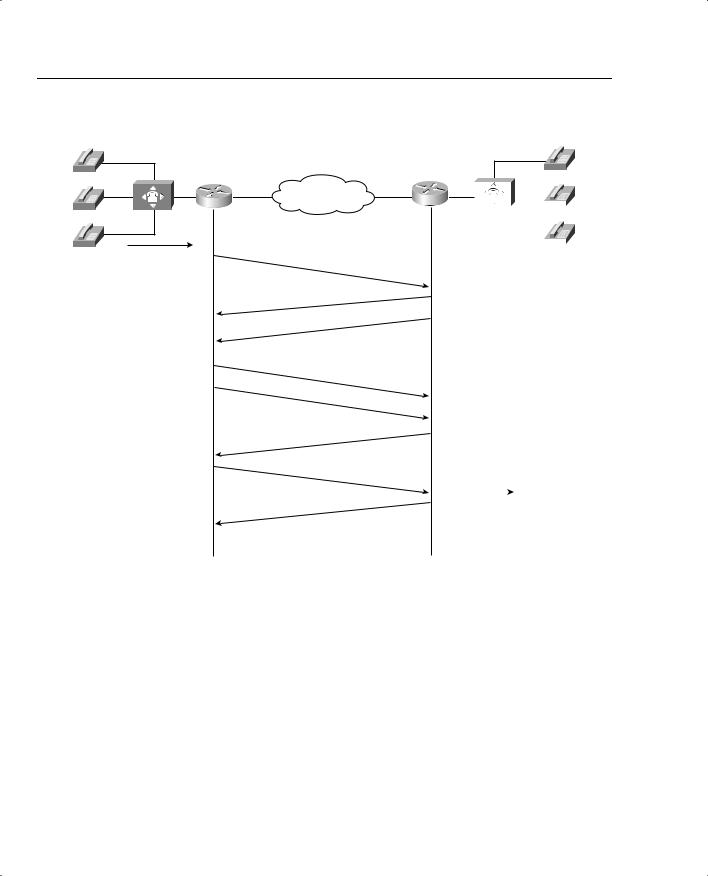
646 Chapter 8: Call Admission Control and QoS Signaling
Figure 8-53 RSVP Call Setup for an H.323 Voice Call
Call Setup
R1 |
|
IP Network |
R2 |
|
|
|
|
|
|
|
|
|||||||
|
|
|
|
|
|
|
|
|
||||||||||
|
|
|
|
|
|
|
|
|
||||||||||
H.225 |
FastStart |
|
|
|
|
|
|
|
|
|||||||||
|
|
|
|
|
|
|
|
|
|
|
||||||||
|
|
|
|
|
|
|
|
|
|
|
||||||||
|
|
|
|
|
|
|
|
|
|
|
||||||||
|
|
|
|
|
|
|
|
|
|
|
||||||||
|
|
|
|
|
|
|
|
|
|
|
||||||||
|
|
|
|
|
|
|
|
|
|
|
||||||||
|
|
|
|
|
|
|
|
|
|
|
|
|
||||||
|
|
|
|
|
|
|
|
Setup |
|
|
|
|
|
|
|
|
|
|
|
H.225 Call |
Proceeding |
|
|
|
|
|
|
|
|
|
|
||||||
|
|
|
|
|
|
|
|
|
|
|
|
|
|
|
||||
|
RSVP |
PATH |
Message |
|
|
|
|
|
|
|
|
|
|
|||||
|
|
|
|
|
|
|
|
|
|
|
|
|
||||||
|
|
|
|
|
|
|
|
|
|
|
|
|
|
|
|
|
||
|
RSVP |
RESV |
|
|
|
|
|
|
|
|
|
|
|
|||||
|
|
|
|
|
|
|
Message |
|
|
|
|
|
|
|
|
|
|
|
|
RSVP |
|
|
|
|
|
|
|
|
|
|
|
|
|
|
|
||
|
|
|
PATH |
|
|
|
|
|
|
|
|
|
|
|
||||
|
|
|
|
|
|
|
Message |
|
|
|
|
|
|
|
|
|
|
|
|
RSVP |
RESV |
Message |
|
|
|
|
|
|
|
|
|
|
|||||
|
|
|
|
|
|
|
|
|
|
|
|
|||||||
|
|
|
|
|
|
|
|
|
|
|
|
|
|
|
|
|||
|
RSVP |
Reservation |
|
|
|
|
|
|
|
|
|
|
||||||
|
|
|
|
|
|
|
|
|
|
|
|
|||||||
|
|
|
|
|
|
|
|
Confirm |
|
|
|
|
|
|
|
|
|
|
|
H.225 |
Alerting |
or |
Connect |
|
Call Setup |
|
|
|
|||||||||
|
|
|
|
|
|
|||||||||||||
|
|
|
|
|
|
|
|
|
|
|
|
|
|
|||||
|
|
|
|
|
|
|
|
|
|
|
|
|
|
|
|
|
|
|
Table 8-42 describes the available options for the acc-qos and req-qos commands.
Table 8-42 acc-qos and req-qos Command Options
acc-qos and req-qos |
|
Command Options |
Function |
|
|
best-effort |
Indicates that RSVP makes no bandwidth reservation. |
|
|
controlled-load |
Indicates that RSVP guarantees a single level of preferential service, |
|
presumed to correlate to a delay boundary. The controlled-load service |
|
uses admission (or capacity) control to ensure that preferential service is |
|
received even when the bandwidth is overloaded. |
|
|
guaranteed-delay |
Indicates that RSVP reserves bandwidth and guarantees a minimum bit |
|
rate and preferential queuing if the bandwidth reserved is not exceeded. |
|
|
This table was derived from the following: www.cisco.com/en/US/partner/products/sw/iosswrel/ps1834/products_feature_guide09186a008008045c.html.

Foundation Summary 647
Table 8-18 summarizes the results of nine call setup scenarios based on the QoS levels that can be configured in the VoIP dial peers at the originating and terminating gateways.
Figure 8-54 illustrates how RSVP uses the priority queue in LLQ for packets matching the voice-like profile.
Figure 8-54 RSVP Packet-Classification Criteria
|
|
|
|
|
Egress Interface / PVC |
||
|
|
|
|
|
|
Queueing (LLQ) |
|
|
|
|
Voice Conforming, Admitted Flows |
|
|
|
|
|
|
|
|
|
|
||
|
|
|
|
Priority |
|
||
|
|
|
|
|
|
|
|
Unclassified |
|
|
|
|
Queue |
|
|
|
|
|
|
|
|
||
Flows |
|
Non-Voice Conforming, Admitted Flows |
|
|
|
||
RSVP |
|
Reserved |
|
||||
|
|
|
|
||||
|
|
|
|
|
|
||
|
|
|
|
|
Queues |
|
|
|
|
Classification |
|
|
|
|
|
|
|
|
|
|
|
|
|
|
|
|
|
|
|
|
|
|
|
|
|
|
|
|
|
|
|
|
|
|
|
Class 1 |
|
|
|
|
|
|
|
|
|
|
|
|
|
|
|
|
|
|
|
|
|
|
|
|
|
|
|
|
|
|
|
Class 2 |
|
|
|
|
Non-Admitted Flows, Voice Signaling |
|
|
|
|
|
|
|
|
|
|
||
|
|
|
|
|
|
||
|
|
|
Traffic, PATH and RESV Messages |
|
Default |
|
|
|
|
|
|
|
|
|
|
|
|
|
|
|
|
Queue |
|
|
|
|
|
|
|
|
|
|
|
|
|
|
|
|
|
Table 8-43 summarizes the bandwidth RSVP allocates for calls using different Cisco IOS gateway codecs.
Table 8-43 RSVP Bandwidth Reservations for Voice Codecs
Codec |
Bandwidth Reserved per Call in LLQ |
|
|
|
|
G.711 |
(A-law and µ-law) |
80 kbps |
|
|
|
G.723.1 and G.723.1A (5.3 kbps) |
22 kbps |
|
|
|
|
G.723.1 and G.723.1A (6.3 kbps) |
23 kbps |
|
|
|
|
G.726 |
(16 kbps) |
32 kbps |
|
|
|
G.726 |
(24 kbps) |
40 kbps |
|
|
|
G.726 |
(32 kbps) |
48 kbps |
|
|
|
G.728 |
|
32 kbps |
|
|
|
G.729 |
(all versions) |
24 kbps |
|
|
|
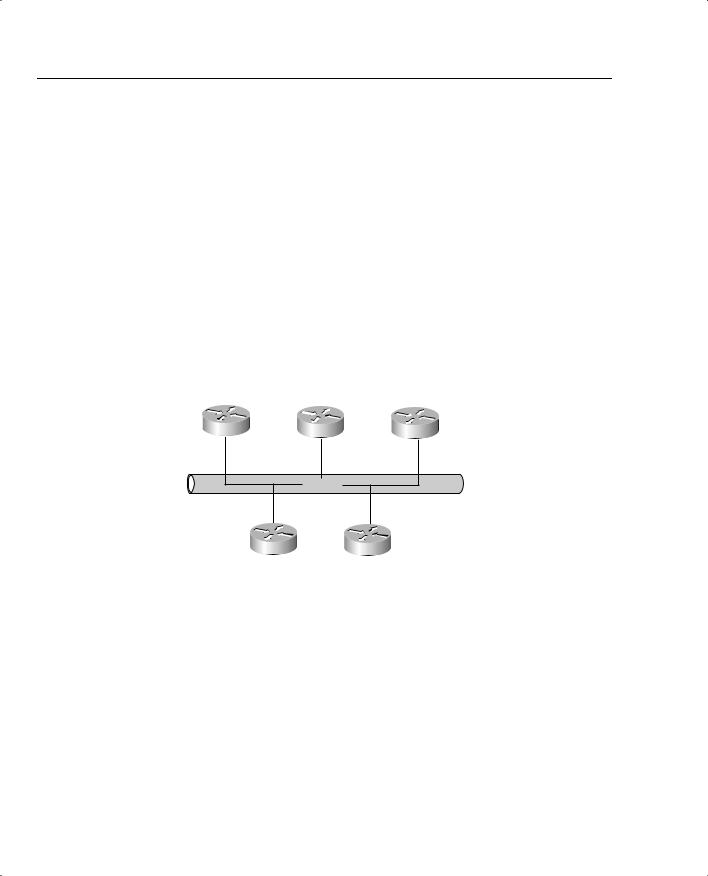
648 Chapter 8: Call Admission Control and QoS Signaling
Table 8-44 lists the commands used to define and enable RSVP.
Table 8-44 RSVP Profile, req-qos and acc-qos Commands
Command |
Mode and Function |
|
|
ip rsvp pq-profile |
Specifies the criteria for determining which flows go into the |
|
priority queue |
|
|
req-qos {best-effort | controlled-load | |
Specifies the desired quality of services requested to be used |
guaranteed-delay} |
in reaching a specified VoIP dial peer |
|
|
acc-qos {best-effort | controlled-load | |
Specifies the acceptable quality of service for any inbound |
guaranteed-delay} |
and outbound call on a VoIP dial peer |
|
|
Figure 8-55 shows a managed segment in a Layer 2 domain that interconnects a group of routers.
Figure 8-55 DSBM Managed Subnet
DSBM Client |
DSBM |
DSBM Client |
Ethernet
DSBM Client |
DSBM Client |

Foundation Summary 649
Table 8-45 lists the commands used to enable and define the DSBM in Example 8-18.
Table 8-45 SBM Commands
Command |
Mode and Function |
|
|
ip rsvp bandwidth |
Enables RSVP on an interface |
|
|
ip rsvp dsbm candidate [priority] |
Configures the interface to participate as a contender in the |
|
DSBM dynamic election process, whose winner is based on the |
|
highest priority |
|
|
ip rsvp dsbm non-resv-send-limit |
Configures the average rate, in kbps, for the DSBM candidate |
rate kbps |
|
|
|
ip rsvp dsbm non-resv-send-limit |
Configures the maximum burst size, in KB, for the DSBM |
burst kilobytes |
candidate |
|
|
ip rsvp dsbm non-resv-send-limit |
Configures the peak rate, in kbps, for the DSBM candidate |
peak kbps |
|
|
|
Table 8-46 lists other RSVP commands that can be useful in monitoring and troubleshooting RSVP.
Table 8-46 RSVP Monitoring and Troubleshooting Commands
Command |
Mode and Function |
|
|
show ip rsvp neighbor [interface-type |
Displays current RSVP neighbors |
interface-number] |
|
|
|
show ip rsvp request [interface-type |
Displays RSVP-related request information being |
interface-number] |
requested upstream |
|
|
show ip rsvp reservation [interface-type |
Displays RSVP-related receiver information currently |
interface-number] |
in the database |
|
|
show ip rsvp sbm [detail] [interface-name] |
Displays information about a SBM configured for a |
|
specific RSVP-enabled interface or for all RSVP- |
|
enabled interfaces on the router |
|
|
show ip rsvp sender [interface-type |
Displays Resource Reservation Protocol (RSVP) |
interface-number] |
PATH-related sender information currently in the |
|
database |
|
|

650 Chapter 8: Call Admission Control and QoS Signaling
Table 8-47 evaluates the RSVP mechanism against the CAC evaluation criteria described earlier in this chapter.
Table 8-47 RSVP CAC Evaluation Criteria
Evaluation Criteria |
Value |
|
|
VoX supported |
VoIP/H.323 only |
|
|
Toll bypass or IP telephony |
Currently trunking only |
|
|
Platforms and releases |
Cisco IOS gateways in Release 12.1(5)T and 12.2 |
|
|
PBX trunk types supported |
All |
|
|
End to end, local, or IP cloud |
End to end between originating gateway and terminating |
|
gatekeeper (provided all intermediate nodes are RSVP |
|
configured) |
|
Could be used at WAN edge with DiffServ backbone |
|
|
Per call, interface, or endpoint |
Per call |
|
|
Topology awareness |
Yes |
|
|
Guarantees QoS for duration of call |
Yes |
|
|
Postdial delay |
Yes |
|
|
Messaging network overhead |
Path/resv and periodic keepalives |
|
|
There is little overlap between local CAC mechanisms and those that look ahead to the rest of the network to determine nonlocal conditions. It is easy to understand why the distinct local and nonlocal mechanisms are useful. However, there is considerable overlap between the measurement techniques and the resource reservation techniques of the two nonlocal, lookahead CAC mechanisms. For this reason, there is debate over which is the better method.
Table 8-48 compares the strengths and weaknesses of the measurement-based and resourcebased CAC mechanisms. With this information, you can determine the best method for your individual network.

Foundation Summary 651
Table 8-48 Comparison of Measurement-Based and Resource Reservation-Based CAC Features
|
Measurement-Based |
Resource Reservation-Based |
Criteria |
Techniques |
Techniques |
|
|
|
Network topology |
Topology independent. |
Topology aware. |
|
The probe travels to a destination IP |
The bandwidth availability on every |
|
address without knowledge of nodes, |
node and every link is taken into |
|
hops, and bandwidth availability on |
account. |
|
individual links. |
|
|
|
|
Backbone |
Transparent. |
To be the truly end-to-end method that |
transparency |
Probes are IP packets and can be sent |
reservation techniques are intended to |
|
be, the feature must be configured on |
|
|
over any network, including SP |
|
|
every interface along the path, which |
|
|
backbones and the Internet. |
|
|
means the customer owns the WAN |
|
|
|
|
|
|
backbone, and all nodes run code that |
|
|
implement the feature. Owning the |
|
|
entire backbone is impractical in some |
|
|
cases, so hybrid topologies may be |
|
|
contemplated—with some |
|
|
compromise to the end-to-end nature |
|
|
of the method. |
|
|
|
Postdial delay |
An increase in postdial delay exists |
An increase in postdial delay exists for |
|
for the first call only. Information on |
every call, because the RSVP |
|
the destination is cached after the first |
reservation must be established before |
|
call, and a periodic probe is sent to the |
the call setup can be completed. |
|
IP destination. Subsequent calls are |
|
|
allowed or denied based on the latest |
|
|
cached information. |
|
|
|
|
Industry parity |
Several vendors have “ping”-like |
None. |
|
CAC capabilities. For a customer |
|
|
familiar with this operation, |
|
|
measurement-based techniques are a |
|
|
good fit. |
|
|
|
|
CAC accuracy |
The periodic sampling rate of probes |
When implemented on all nodes in the |
|
can potentially admit calls when |
path, RSVP guarantees bandwidth for |
|
bandwidth is insufficient. |
the call along the entire path for the |
|
Measurement-based techniques |
entire duration of the call. This is the |
|
perform well in networks where traffic |
only technique that achieves this level |
|
fluctuations are gradual. |
of accuracy. |
|
|
|
continues

652 Chapter 8: Call Admission Control and QoS Signaling
Table 8-48 Comparison of Measurement-Based and Resource Reservation-Based CAC Features (Continued)
|
Measurement-Based |
Resource Reservation-Based |
Criteria |
Techniques |
Techniques |
|
|
|
Protecting voice |
The CAC decision is based on probe |
A reservation is established per call |
QoS after |
traffic statistics before the call is |
before the call is admitted. The quality |
admission |
admitted. After admission, the call |
of the call is therefore unaffected by |
|
quality is determined by the |
changes in network traffic conditions. |
|
effectiveness of other QoS |
|
|
mechanisms in the network. |
|
|
|
|
Network traffic |
Periodic probe traffic overhead to a |
RSVP messaging traffic overhead for |
overhead |
cached number of IP destinations. |
every call. |
|
Both the interval and the cache size |
|
|
can be controlled by the configuration. |
|
|
|
|
Scalability |
Sending probes to thousands of |
Individual flow reservation is |
|
individual IP destinations may be |
important on the small-bandwidth |
|
impractical in a large network. Probes |
links around the edge of the network. |
|
can be sent to the WAN edge devices, |
However, individual reservations per |
|
however, which proxy on behalf of |
call flow may not make sense on large- |
|
many more destinations on a high- |
bandwidth links in the backbone such |
|
bandwidth campus network behind |
as an OC-12. Hybrid network |
|
the edge. This provides considerable |
topologies can solve this need, and |
|
scalability, because the WAN is much |
additional upcoming RSVP tools in |
|
more likely to be congested than the |
this space will provide further |
|
campus LAN. |
scalability. |
|
|
|
Table 8-49 summarizes the 11 different voice CAC mechanisms that have been discussed in chapter. It also lists the first Cisco IOS release in which the feature became available.
Table 8-49 Summary of CAC Features
Type |
CAC Feature |
SW Release |
|
|
|
Local |
|
|
|
|
|
|
Physical DS0 limitation |
SW independent |
|
|
|
|
Max-Connections on the dial peer |
11.3 |
|
|
|
|
VoFR Voice-Bandwidth |
12.0.(4)T |
|
|
|
|
Trunk conditioning |
12.1.(2)T |
|
|
|
|
Local Voice Busyout (LVBO) |
12.1.(2)T |
|
|
|
Measurement based |
|
|
|
|
|
|
Advanced Voice Busyout (AVBO) |
12.1.(3)T |
|
|
|
|
PSTN fallback |
12.1.(3)T |
|
|
|

|
|
|
|
|
|
|
|
|
|
Foundation Summary 653 |
||
|
|
|
|
|
|
|
|
|
|
|
|
|
Table 8-49 Summary of CAC Features (Continued) |
|
|
|
|
|
|
|
|||||
|
|
|
|
|
|
|
|
|
|
|
|
|
|
Type |
|
CAC Feature |
|
|
|
SW Release |
|
|
|||
|
|
|
|
|
|
|
|
|
|
|
|
|
|
Resource based |
|
|
|
|
|
|
|
|
|
|
|
|
|
|
|
|
|
|
|
|
|
|
|
|
|
Resource calculation |
|
|
|
|
|
|
|
|
|
|
|
|
|
|
|
|
|
|
|
|
|
|
|
|
|
|
|
Resource availability indication |
|
12.0.(5)T (AS5300) |
|
||||||
|
|
|
|
|
|
|
|
|
12.1.(3)T (2600/3600) |
|
||
|
|
|
|
|
|
|
|
|
|
|
|
|
|
|
|
CallManager location-based CAC |
|
CallManager 3.0 |
|
|
|||||
|
|
|
|
|
|
|
|
|
AAR was added in CallManager |
|||
|
|
|
|
|
|
|
|
|
release 3.3 |
|
|
|
|
|
|
|
|
|
|
|
|
|
|
|
|
|
|
|
Gatekeeper zone bandwidth |
|
11.(3) (local zone) |
|
||||||
|
|
|
|
|
|
|
|
|
12.1.(5)T (interzone) |
|
||
|
|
|
|
|
|
|
|
|
|
|
|
|
|
Resource reservation |
|
|
|
|
|
|
|
|
|
|
|
|
|
|
|
|
|
|
|
|
|
|
|
|
|
|
|
Resource Reservation Protocol |
|
12.1.(5)T |
|
|
|||||
|
|
|
|
|
|
|
|
|
|
|
||
|
Table 8-50 summarizes the voice technologies supported by the CAC methods discussed in this |
|||||||||||
|
chapter. |
|
|
|
|
|
|
|
|
|
|
|
Table 8-50 Summary of Voice Technologies supported |
|
|
|
|
|
|
||||||
|
|
|
|
|
|
|
|
|
|
|
|
|
|
|
|
|
VoIP |
|
VoIP |
VoIP |
|
|
|
|
H.323 |
|
Feature |
|
H.323 |
|
SIP |
MGCP |
VoFR |
VoATM |
CM |
Video |
||
|
|
|
|
|
|
|
|
|
|
|||
|
Physical DS0 limitation |
Yes |
|
Yes |
Yes |
Yes |
Yes |
No |
No |
|||
|
|
|
|
|
|
|
|
|
|
|
||
|
Max-Connections |
|
Yes |
|
Yes |
Yes |
Yes |
Yes |
No |
No |
||
|
|
|
|
|
|
|
|
|
|
|
||
|
Voice-Bandwidth |
|
No |
|
No |
No |
Yes |
No |
No |
No |
||
|
|
|
|
|
|
|
|
|
|
|
||
|
Trunk conditioning |
|
Yes |
|
Yes |
Yes |
Yes |
Yes |
No |
No |
||
|
|
|
|
|
|
|
|
|
|
|
||
|
Local Voice Busyout |
|
Yes |
|
Yes |
Yes |
Yes |
Yes |
No |
No |
||
|
|
|
|
|
|
|
|
|
|
|||
|
Advanced Voice Busyout |
Yes |
|
Yes |
Yes |
No |
No |
No |
No |
|||
|
|
|
|
|
|
|
|
|
|
|
||
|
PSTN fallback |
|
Yes |
|
Yes |
Yes |
No |
No |
No |
No |
||
|
|
|
|
|
|
|
|
|
|
|
||
|
Resource availability |
|
Yes |
|
No |
No |
No |
No |
No |
No |
||
|
indication |
|
|
|
|
|
|
|
|
|
|
|
|
|
|
|
|
|
|
|
|
|
|
||
|
CallManager locations |
|
Yes |
|
No |
Yes |
Yes |
Yes |
Yes |
No |
||
|
|
|
|
|
|
|
|
|
|
|
||
|
Gatekeeper zone |
|
Yes |
|
No |
No |
No |
No |
Yes |
Yes |
||
|
bandwidth |
|
|
|
|
|
|
|
|
|
|
|
|
|
|
|
|
|
|
|
|
|
|
||
|
Resource Reservation |
|
Yes |
|
No |
No |
No |
No |
No |
No |
||
|
Protocol |
|
|
|
|
|
|
|
|
|
|
|
|
|
|
|
|
|
|
|
|
|
|
|
|
